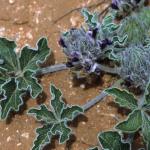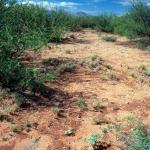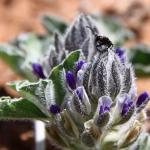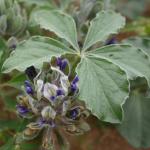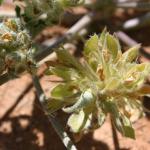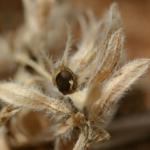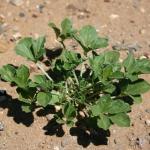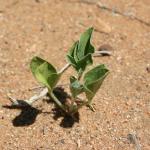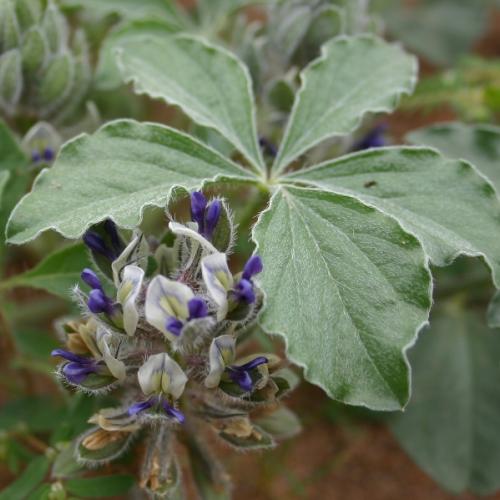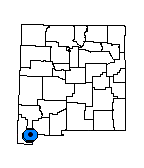Description
Perennial herb up to about 25 cm tall, grayish-hairy with straight hairs that lie against the surface of the foliage; stems with a thin, cord-like, easily broken, subterranean portion bearing a few small bracts, and a very short aerial, leafy portion; root a deeply buried fusiform taproot; leaves with minute, dark, glandular dots, palmately (or very shortly pinnately) compound, with petioles 8-15 cm long; leaflets 5 (rarely 6), lanceolate, rhombic or oblanceolate, 2-5 cm long, the lower surface more densely hairy than upper; flowers in a dense ovoid grayish-hairy cluster 2-4 cm long, 2-2.5 cm wide, on a peduncle 4-9 cm long, each flower bilaterally symmetrical, pea-like, 14-18 mm long, purple; fruit a small pod 7-8 mm long, barely surpassing the calyx teeth. Flowers in April and May, and again in July and August, depending on rainfall.
Similar Species
In New Mexico, no other Pediomelum grows within the range of P. pentaphyllum that can be confused with it. Slightly to the west, in Arizona, P. megalanthum is similar, but has more perfectly palmately compound (rather than shortly pinnately compound) leaves with 5-8 leaflets that are often broadly rounded at the tip.
Distribution
New Mexico, Hidalgo County; adjacent Arizona, Cochise and Graham counties; possibly Texas, Presidio County (?); Mexico, Chihuahua, south to about Ciudad Chihuahua.
Habitat
Desert grassland or desertscrub among creosote bush or mesquite in sandy or gravelly loam soils; 1,350-2,000 m (4,400-6,600 ft) [a specimen at NMC with indefinite locality, Arizona, Graham County, near Lower San Simon Plot, Anderson and Rhinehart 953, has elevation recorded as 3,000 ft; a check against topo maps indicates elevation of about 1,100 m (3,600 ft ) in this general region].
Conservation Considerations
The plant is widespread, but according to Grimes (1990) is "an uncommon species." One 1936 collection in the New Mexico State University herbarium (Anderson and Rhinehart 953, from Graham County, Arizona) states the species is common. However, this plant was not collected again in Arizona until 1965. Likewise, the single known New Mexico location was originally collected in 1937 and not found again until 1995. Its palatability to domestic livestock or response to disturbance in arid grasslands is not recorded. Collectors sometimes note that the species occurs in open areas. Status of this species is unknown in Mexico and the impact of medicinal collecting on populations is undetermined.
Important Literature
Grimes, J.W. 1990. A revision of the New World species of Psoraleae (Leguminosae: Papilionoideae). Memoirs of the New York Botanical Garden 61:1-114.
Martin, W.C. and C.R. Hutchins. 1980. A flora of New Mexico, vols. 1-2. J. Cramer, Vaduz.
Wooton, E.O. and P.C. Standley. 1915. Flora of New Mexico. Contributions from the U.S. National Herbarium 19:1-794.
Rydberg, P.A. 1919. Psoralea. North American Flora 24(2):1-64.

